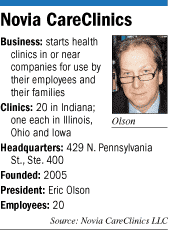Subscriber Benefit
As a subscriber you can listen to articles at work, in the car, or while you work out. Subscribe NowCutting out the middleman is a time-tested way of saving money.
And it seems to be picking up steam in Indiana health care.
The St. Vincent Health hospital system has joined with Indianapolis-based Novia CareClinics LLC to set
up clinics on employers’ campuses, offering health care for their workers with no insurance companies involved.
The two companies promise savings because this direct contracting can include wholesale instead
of retail prices—not to mention the hope of cost saving by having an on-site
clinic catch big-dollar health problems before they explode.
And they’re getting more than a few bites so far. Since St. Vincent and Novia joined forces in
July, when they opened a clinic at Zionsville Community Schools, they have signed
up four more employers.
Those include Hillenbrand Inc.
in Batesville, Youth Opportunity in Muncie, and the cities of Kokomo and Noblesville. And the say they’re
in discussions with many more employers.
“This
is where health care is headed,” said Kevin Speer, chief strategy officer for St.
Vincent Health, the Indiana subsidiary of Ascension Health, a St. Louis-based chain of Catholic
hospitals. “It’s going to be of greater and greater interest to employers as we move
forward.”
No one, Speer included, sees direct
contracting replacing health insurance. But these direct relationships can be structured
with financial incentives for hospital systems to keep patients out of
their facilities—something that would require a massive overhaul
of insurance plans’ payment systems.
“The
real savings comes through a better relationship between the employee and the
health care provider,” said John Bridge, executive vice president of Novia Care. “The provider is paid
based on time spent, not on volume of patients.”
Employers with
Novia clinics typically make their clinics’ services available free to their
employees and dependents. They pay for a 40-minute initial visit with the clinic
doctor, then 20 minutes for each appointment after that.
The average time for a visit to a primary care doctor in a typical
office setting is 20 minutes.
St. Vincent is not
the first local hospital system to go down this road.
Clarian Health
is considering direct contracting once it puts together an army of physicians who all will commit to work
together to treat patients. Some of those physicians will become employees of the Indiana Clinic, Clarian’s joint venture
with the Indiana University Medical Group. Others will align their financial interests with Clarian under its Clarian Quality
Partners program.
Also, Clarian and Community Health Network have been
providing on-site wellness programs for employers the last few years—with
impressive results for such companies as Celadon Group and Monarch Beverage.
St. Vincent also is using Novia Care to take it into areas of the state where it currently has
no presence, such as Batesville. That can only lead to extra referrals to St. Vincent hospitals down
the road.
Novia Care first went to Batesville
in early 2007, opening a clinic at Batesville Tool & Die, an auto-parts maker.
 The company, which acts as its own health insurer, saw
The company, which acts as its own health insurer, saw
its per-employee health costs shoot up 18 percent from 2004 to 2006. But after
it opened the clinic, costs held steady for two years at about $7,800 per
worker.
Those savings have come, for example, because a few
workers with heart trouble got help before having heart attacks, said Jim Menser,
cost and benefits manager at Batesville Tool & Die. In
addition, the company saves on medical procedures, paying about $12 for blood tests
performed at the clinic versus $150 at the local hospital.
Costs have jumped this year after the company laid off a
bunch of workers but is still funding their health care costs
under the COBRA coverage. It also has seven people on its health plan who have been
diagnosed with cancer this year.
“I’m still better off than if I just accepted a 9-percent increase every
year,” Menser said. He’s also encouraged because 10 times as many people
on the company’s health plan are using the clinic as participated
in various wellness programs the company had tried before.
He liked
the direct contracting so much that he signed a deal this year with a Cincinnati
chain of imaging centers, which he predicts will save about 40 percent on MRIs,
CT scans and other diagnostic tests.
“I think that’s going
to work out well for us,” he said.•
Please enable JavaScript to view this content.
